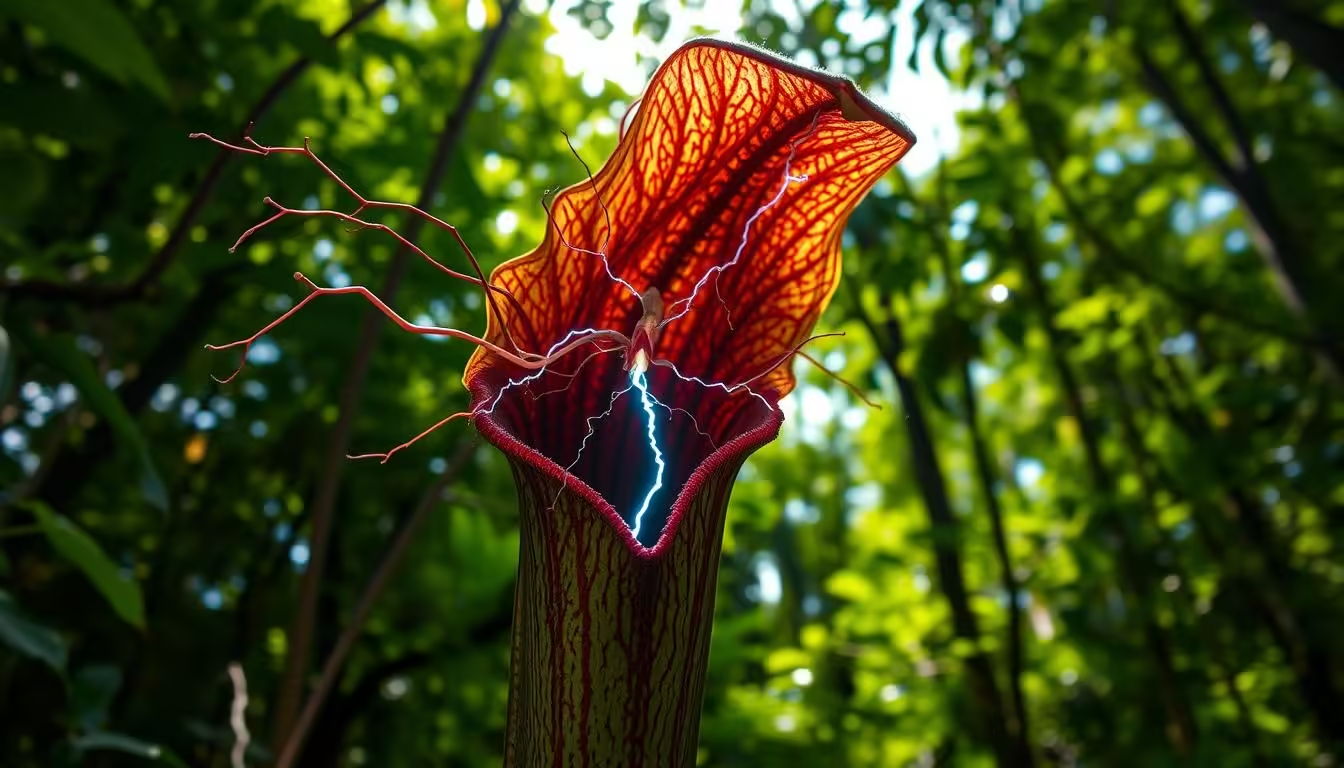A groundbreaking discovery was made in the heart of Borneo’s lush rainforest in 2024. A carnivorous plant, known as the pitcher plant, has evolved to zap insects with electrical pulses, effectively sealing its traps.

This remarkable adaptation not only enhances the plant’s capture efficiency but also opens new avenues for scientific research into bioelectricity in plants. The discovery paints a fascinating picture of the jungle as an electric ecosystem where plants have evolved complex mechanisms to snare their prey.
Key Takeaways
- The Borneo pitcher plant has evolved to use electrical pulses to capture insects.
- This unique adaptation was discovered in 2024 in Borneo’s rainforest.
- The plant’s bioelectricity has potential applications in pest control.
- The discovery opens new avenues for research into plant bioelectricity.
- The jungle is revealed as an electric ecosystem with complex plant mechanisms.
The Electrifying Discovery in Borneo’s Rainforest
Borneo’s rainforest holds a secret: a pitcher plant that zaps insects with electrical pulses. This remarkable discovery, made in 2024, has opened new avenues in understanding the complex interactions between plants and their environment.

First Observations of the Electric Pitcher Plant
The journey into the heart of Borneo’s rainforest led to the first observations of the electric pitcher plant. Initial observations revealed a plant that not only captured insects through its slippery surface but also delivered an electrical shock to ensure its prey was trapped. This unique adaptation sparked a flurry of research into the mechanisms behind this electrical pulse.
The 2024 Scientific Breakthrough
The scientific breakthrough achieved in 2024 highlighted the complex evolutionary adaptations that enable certain species to thrive in challenging ecosystems. Scientists were eager to understand the intricacies of this adaptation, leading to a deeper exploration of the plant’s electrical signaling systems. The discovery marked a significant milestone in the field of botany, showcasing the incredible diversity of plant life in Borneo’s rainforest.
The electric pitcher plant’s ability to zap insects with electrical pulses is a testament to the innovative adaptations that have evolved in the natural world. As research continues, we may uncover more secrets hidden within the depths of Borneo’s rainforest.
Understanding Pitcher Plants: Traditional Trapping Mechanisms
Pitcher plants have long been a subject of fascination due to their unique methods of capturing prey. These carnivorous plants have evolved sophisticated trapping mechanisms that enable them to thrive in nutrient-poor environments.
How Conventional Pitcher Plants Capture Prey
Conventional pitcher plants capture prey through a combination of slippery surfaces, deep cavities filled with digestive fluids, and often, a lid that prevents escape. The slippery surface around the pitcher’s rim makes it difficult for insects to maintain their footing, causing them to fall into the digestive fluid-filled cavity below. Once inside, the insects are trapped and eventually digested, providing the plant with essential nutrients.
The effectiveness of this mechanism is enhanced by the plant’s ability to produce nectar that attracts prey. This combination of attraction and trapping is a key factor in the plant’s survival.
The Diversity of Pitcher Plants in Southeast Asia
Southeast Asia is home to a diverse range of pitcher plant species, each adapted to different environments. From the lush forests of Borneo to the mountainous regions of Sumatra, pitcher plants have evolved to thrive in various ecosystems. This diversity is a testament to the plant’s adaptability and its ability to exploit different ecological niches.
Some species have adapted to high-altitude environments, while others thrive in lowland forests. This adaptability has resulted in a rich variety of pitcher plant species, each with unique characteristics suited to their specific environment.

In Borneo, a Pitcher Plant Zaps Insects with Pulses, Sealing Traps
A groundbreaking discovery in Borneo has unveiled a pitcher plant that uses electrical pulses to immobilize insects. This remarkable adaptation has significant implications for our understanding of carnivorous plants and their evolutionary strategies.

The Unique Electrical Mechanism Explained
The electric pitcher plant in Borneo has developed a sophisticated electrical mechanism that allows it to generate pulses strong enough to zap insects that come into contact with it. This is achieved through specialized structures within the plant that produce electrical discharges. The pulses are carefully calibrated to be strong enough to immobilize insects without causing damage to the plant itself, showcasing the intricate balance of this evolutionary adaptation.
The electrical mechanism is a complex process involving the coordination of various cellular and physiological components. It represents a significant advancement over traditional trapping methods used by other pitcher plants, offering a more effective means of capturing prey in a competitive environment.
How the Pulses Enhance Capture Efficiency
The electrical pulses generated by the pitcher plant significantly enhance its capture efficiency. By zapping insects, the plant ensures that they are trapped and unable to escape, thereby increasing its chances of obtaining nutrients. This mechanism is particularly effective in Borneo’s rainforest environment, where the competition for resources is high.
The use of electrical pulses allows the plant to capture a wider range of insects, including those that might otherwise be able to escape from traditional pitcher plants. This adaptation not only enhances the plant’s survival chances but also provides it with a competitive edge in its ecosystem.
The Science Behind Bioelectricity in Plants
Bioelectricity in plants is a rapidly expanding field, with recent findings shedding light on complex electrical signaling systems. Plants generate electrical impulses in response to various stimuli, from light and touch to injury and environmental changes. These electrical signals play a crucial role in coordinating activities within the plant.

Plant Electrical Signaling Systems
Plant electrical signaling systems are intricate networks that allow plants to respond to their environment. These systems involve the generation and propagation of electrical impulses, which can trigger various physiological responses. For instance, when a plant is injured, electrical signals can initiate defense mechanisms to protect it from further damage.
The electric pitcher plant’s unique adaptation is a prime example of how bioelectricity can be used for capturing prey. By generating electrical pulses, the plant can attract and trap insects more effectively. This mechanism is thought to be linked to the plant’s overall electrical signaling system, which coordinates various activities.
Key aspects of plant electrical signaling include:
- Generation of electrical impulses in response to stimuli
- Propagation of electrical signals throughout the plant
- Triggering of physiological responses, such as defense mechanisms
Measuring and Detecting Plant Electrical Activity
Scientists are developing sophisticated methods to measure and detect plant electrical activity. Techniques such as electrophysiology and voltage-sensitive dyes are being used to study the electrical properties of plants. These methods allow researchers to gain insights into the complex electrical signaling systems that underpin plant behavior.
By studying the bioelectricity of the electric pitcher plant, researchers can gain a deeper understanding of how this unique adaptation is integrated into the plant’s overall physiology. This knowledge can have implications for our understanding of plant communication and behavior.
- Electrophysiology techniques are used to measure electrical activity in plants.
- Voltage-sensitive dyes help visualize electrical signals in plant tissues.
Borneo’s Unique Ecosystem: A Perfect Environment for Evolution
The dense, vibrant rainforests of Borneo are home to a multitude of species that have developed remarkable traits to survive and thrive. This biodiversity hotspot is characterized by nutrient-poor soils, high rainfall, and intense sunlight, creating an environment where plants must compete fiercely for resources.

In such a competitive environment, carnivorous plants like the pitcher plant have evolved innovative strategies to capture prey. The electric pitcher plant’s adaptation is a prime example of how plants in Borneo have developed unique mechanisms to enhance their survival chances.
The Rich Biodiversity of Borneo’s Rainforests
Borneo’s rainforests are renowned for their rich biodiversity, hosting a wide array of flora and fauna. This diversity is supported by the region’s unique geography, which includes vast areas of untouched rainforest and a variety of habitats ranging from lowland forests to mountainous regions.
- The rainforests are home to a vast number of plant species, many of which are found nowhere else on Earth.
- The diverse array of insects and other small animals provides a rich source of nutrients for carnivorous plants.
- The complex ecosystem supports a delicate balance between predators and prey, driving the evolution of unique adaptations.
Environmental Factors Driving Carnivorous Plant Adaptations
Several environmental factors have driven the evolution of carnivorous plants in Borneo. The nutrient-poor soils mean that plants must obtain essential nutrients by capturing and digesting insects. High rainfall and intense sunlight also play a role, as they support the growth of lush vegetation but also increase competition for limited resources.
Key environmental factors include:
- Nutrient-poor soils that necessitate alternative nutrient acquisition strategies.
- High competition for resources among plant species.
- A diverse array of insects that can be captured for nutrients.
As noted by botanists, “The unique combination of environmental factors in Borneo’s rainforests has led to the evolution of some of the most fascinating and complex plant species on the planet.”
“The discovery of the electric pitcher plant in Borneo highlights the incredible diversity and adaptability of life in these ecosystems.”
Research Methods: How Scientists Documented the Electric Traps
Scientists have employed innovative research methods to study the electric pitcher plant’s ability to capture insects. The study of this unique plant required a comprehensive approach, combining field observations with laboratory analyses.
Field Observation Techniques
In the field, researchers used camera traps and direct observation to monitor the plant’s behavior and capture insects. These techniques allowed scientists to understand how the electric pitcher plant operates in its natural habitat. Camera traps provided valuable insights into the plant’s interaction with insects, while direct observation enabled researchers to note the plant’s behavior in real-time.
Laboratory Analysis of the Electrical Pulses
In the laboratory, researchers analyzed the electrical pulses generated by the plant using equipment such as electrometers to measure the voltage and current. The data collected from these analyses helped scientists understand the role of electrical pulses in capturing prey. The results are summarized in the following table:
| Measurement | Value | Unit |
|---|---|---|
| Voltage | 10-20 | mV |
| Current | 1-5 | mA |
| Pulse Frequency | 1-10 | Hz |
The combination of field observations and laboratory analyses provided a comprehensive understanding of the electric pitcher plant’s trapping mechanism. By employing these research methods, scientists were able to shed light on the intricacies of the plant’s behavior and its unique electrical properties.
Potential Applications Inspired by Nature’s Electric Trap
The electric pitcher plant’s innovative trapping mechanism is sparking interest in developing more effective and environmentally friendly pest control solutions. This unique adaptation has the potential to inspire new technologies in biomimicry, particularly in the field of pest control.
The study of the electric pitcher plant’s electrical pulses can lead to the development of novel pest control methods that are both sustainable and targeted. By mimicking the plant’s mechanism, researchers aim to create electric traps that can efficiently capture pests without harming beneficial insects.
Biomimicry in Pest Control Technology
Biomimicry involves developing technological solutions inspired by nature. In the context of pest control, the electric pitcher plant’s unique mechanism offers a promising model. Some potential applications include:
- Development of electric traps that mimic the pitcher plant’s electrical pulses
- Creation of targeted pest control systems that reduce harm to non-target species
- Innovative agricultural practices that integrate biomimicry-inspired pest control methods
Sustainable Insect Management Solutions
The electric pitcher plant’s trapping mechanism also offers insights into sustainable insect management. By understanding how the plant’s electrical pulses enhance capture efficiency, researchers can develop more effective and environmentally friendly solutions for managing insect populations.
Some potential benefits of these solutions include:
- Reduced reliance on chemical pesticides
- More targeted and efficient pest control methods
- Promotion of sustainable agricultural practices
As research continues to uncover the secrets of the electric pitcher plant, the potential for biomimicry-inspired innovations in pest control and sustainable insect management grows. These advancements have the potential to transform agricultural practices and contribute to a more sustainable future.
Future Research Directions: What’s Next for Plant Bioelectricity
The discovery of the electric pitcher plant in Borneo has sparked a new wave of research into plant bioelectricity. As scientists delve deeper into this phenomenon, they are uncovering a complex world of electrical signaling in plants. This new area of study holds significant promise for advancing our understanding of plant behavior and potentially revolutionizing various fields, from agriculture to pest control.
Unanswered Questions About the Electric Pitcher Plant
Despite the exciting discovery, many questions remain unanswered about the electric pitcher plant. For instance, researchers are still trying to understand how the plant generates and controls its electrical pulses. Is it a complex process involving multiple cellular components, or a relatively simple mechanism? Investigating these questions will be crucial for fully grasping the plant’s unique characteristics.
A detailed analysis of the plant’s electrical activity could reveal new insights into its behavior. The table below summarizes some of the key areas of ongoing research:
| Research Area | Description | Potential Outcomes |
|---|---|---|
| Electrical Pulse Generation | Understanding how the plant produces electrical pulses | Insights into cellular mechanisms and potential applications in bioengineering |
| Control Mechanisms | Investigating how the plant regulates its electrical signals | Better understanding of plant behavior and potential for improving crop yields |
| Ecological Significance | Examining the role of electrical signals in the plant’s ecosystem | New perspectives on plant interactions with the environment |
Expanding Our Understanding of Plant Communication
The study of the electric pitcher plant is not only shedding light on this unique species but also expanding our understanding of plant communication more broadly. The discovery suggests that electrical signals may play a more significant role in plant behavior than previously thought. This has profound implications for our understanding of how plants interact with their environment and each other.
As research continues, scientists are likely to uncover new ways in which plants use electrical signals to communicate. This could lead to innovative approaches in agriculture, such as developing more efficient methods for monitoring and responding to plant needs. The image below illustrates the complex electrical signaling system in plants:
By exploring the frontiers of plant bioelectricity, researchers are poised to make groundbreaking discoveries that could transform our understanding of the plant kingdom.
Conclusion: Redefining Our Understanding of Carnivorous Plants
The discovery of the electric pitcher plant in Borneo’s rainforest has significantly advanced our knowledge of carnivorous plants. By utilizing electrical pulses to capture insects, this unique plant has evolved a sophisticated adaptation that enhances its capture efficiency. This breakthrough finding redefines our understanding of carnivorous plants, showcasing the complex and diverse strategies they employ to thrive in nutrient-poor environments.
As research continues to unravel the intricacies of the electric pitcher plant’s mechanism, it opens new avenues for innovation in fields such as pest control and sustainable agriculture. The study of this extraordinary plant highlights the fascinating world of plant biology, full of surprises and opportunities for discovery. By exploring and understanding these unique adaptations, we can gain valuable insights into the natural world and potentially develop novel solutions inspired by nature’s ingenuity.
FAQ
What is unique about the pitcher plant found in Borneo?
The pitcher plant in Borneo is unique because it zaps insects with electrical pulses, sealing its traps and enhancing capture efficiency.
How does the electric pitcher plant capture its prey?
The electric pitcher plant captures its prey by generating electrical pulses that zap insects, ensuring they are trapped and unable to escape, in addition to its slippery surface.
What is the significance of the discovery of the electric pitcher plant?
The discovery of the electric pitcher plant is significant because it opens new avenues for research into bioelectricity in plants and has potential applications in pest control and sustainable agriculture.
How does the electric pitcher plant’s mechanism compare to conventional pitcher plants?
Unlike conventional pitcher plants that rely solely on slippery surfaces and digestive fluids, the electric pitcher plant uses electrical pulses to enhance its capture efficiency, making it a more effective carnivorous plant.
What are the potential applications of the electric pitcher plant’s technology?
The electric pitcher plant’s technology has potential applications in biomimicry for pest control, leading to sustainable insect management solutions that are environmentally friendly.
What does the discovery of the electric pitcher plant reveal about Borneo’s ecosystem?
The discovery reveals that Borneo’s rainforests are rich in biodiversity and foster the evolution of complex plant species, with environmental factors driving adaptations in carnivorous plants like the electric pitcher plant.
How do scientists study the bioelectricity of plants like the electric pitcher plant?
Scientists study the bioelectricity of plants by measuring and detecting electrical activity using equipment like electrometers, and by observing plant behavior in both field and laboratory settings.
What are the future research directions for plant bioelectricity?
Future research directions include exploring the mechanisms behind the electric pitcher plant’s electrical pulses, understanding how these signals are generated and controlled, and expanding our understanding of plant communication through electrical signals.









